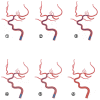A Novel Endovascular Therapy Strategy for Acute Ischemic Stroke Due to Intracranial Atherosclerosis-Related Large Vessel Occlusion: Stent-Pass-Aspiration-resCuE-Micowire-Angioplasty (SPACEMAN) Technique
- PMID: 35237229
- PMCID: PMC8882581
- DOI: 10.3389/fneur.2022.798542
A Novel Endovascular Therapy Strategy for Acute Ischemic Stroke Due to Intracranial Atherosclerosis-Related Large Vessel Occlusion: Stent-Pass-Aspiration-resCuE-Micowire-Angioplasty (SPACEMAN) Technique
Abstract
Background: There is no clear consensus on the optimal endovascular treatment strategy for patients with ischemic stroke caused by ICAS-related large vessel occlusion (LVO). SPACEMAN, a novel thrombectomy technique that entails passing an aspiration catheter over the stent retriever and then retaining the microwire for angioplasty, has not been described. The aim of this prospective study was to evaluate our initial application of SPACEMAN and compare this technique with the Solumbra technique.
Methods: Forty-four consecutive patients with acute ischemic stroke resulting from ICAS-related LVO were randomly divided into two groups: Solumbra group (n = 22) and SPACEMAN group (n = 22). Demographic and clinical data were prospectively collected. Modified Rankin Scale (mRS) score of ≤ 2 of anterior circulation and mRS score ≤ 3 of posterior circulation at 3 months post-discharge was regarded as good prognosis.
Results: The SPACEMAN group showed reduced mean time from femoral access to recanalization compared with the Solumbra group (39.55 ± 10.63 min vs. 50.73 ± 9.89 min, P = 0.001). The overall recanalization rate in the entire cohort was 93.18% (41/44). At 3-month follow-up, the overall good prognosis rate was 47.73%; 13 patients (59.09%) in the SPACEMAN group and 8 (36.36%) in the Solumbra group showed good prognosis. One patient in the SPACEMAN group (4.55%) and two patients in the Solumbra group (9.09%) developed symptomatic intracranial hemorrhage. The overall mortality rate was 4.55% (2/44).
Conclusions: This study suggests that SPACEMAN exhibits a shorter operation revascularization time than the standard thrombectomy. Complications and prognosis were comparable between the two groups. The safety and efficacy of this novel technique need to be studied in larger patient series.
Keywords: SPACEMAN; Solumbra; endovascular therapy; intracranial atherosclerosis; large vessel occlusion.
Copyright © 2022 Wu, Wang, Sun, Feng, Li, Gui and Zheng.
Conflict of interest statement
The authors declare that the research was conducted in the absence of any commercial or financial relationships that could be construed as a potential conflict of interest.
Figures



Similar articles
-
Endovascular Management of Intracranial Atherosclerosis-Related Large Vessel Occlusion With the A Direct Aspiration First-Pass Thrombectomy Compared With Solumbra Technique.Front Neurol. 2021 Mar 2;12:643633. doi: 10.3389/fneur.2021.643633. eCollection 2021. Front Neurol. 2021. PMID: 33737905 Free PMC article.
-
Outcomes of Endovascular Treatment for Acute Intracranial Atherosclerosis-Related Large Vessel Occlusion.Stroke. 2018 Nov;49(11):2699-2705. doi: 10.1161/STROKEAHA.118.022327. Stroke. 2018. PMID: 30355204
-
Endovascular Treatment of Acute Ischemic Stroke Due to Intracranial Atherosclerotic Large Vessel Occlusion : A Systematic Review.Clin Neuroradiol. 2020 Dec;30(4):777-787. doi: 10.1007/s00062-019-00839-4. Epub 2019 Oct 15. Clin Neuroradiol. 2020. PMID: 31616958
-
Comparison of clinical outcomes in patients with acute ischemic strokes treated with mechanical thrombectomy using either Solumbra or ADAPT techniques.J Neurointerv Surg. 2016 Nov;8(11):1123-1128. doi: 10.1136/neurintsurg-2015-012122. Epub 2015 Dec 14. J Neurointerv Surg. 2016. PMID: 26667250
-
Endovascular Treatment of Acute Stroke Due to Intracranial Atherosclerotic Stenosis-Related Large Vessel Occlusion.Front Neurol. 2019 Apr 2;10:308. doi: 10.3389/fneur.2019.00308. eCollection 2019. Front Neurol. 2019. PMID: 31001193 Free PMC article. Review.
Cited by
-
Rescue therapy after thrombectomy for large vessel occlusion due to underlying atherosclerosis: review of literature.Front Neurol. 2023 Jun 16;14:1181295. doi: 10.3389/fneur.2023.1181295. eCollection 2023. Front Neurol. 2023. PMID: 37396754 Free PMC article. Review.
-
Association between basilar artery stenosis features, vertebral artery stenosis and perforator stroke after stenting.Interv Neuroradiol. 2025 Apr;31(2):246-254. doi: 10.1177/15910199231164840. Epub 2023 Mar 29. Interv Neuroradiol. 2025. PMID: 36987683 Free PMC article.
-
Application of Balloon AngioplaSty with the dIstal protection of Stent Retriever (BASIS) technique for acute intracranial artery atherosclerosis-related occlusion.Front Neurol. 2022 Nov 17;13:1049543. doi: 10.3389/fneur.2022.1049543. eCollection 2022. Front Neurol. 2022. PMID: 36523347 Free PMC article.
References
-
- Powers WJ, Rabinstein AA, Ackerson T, Adeoye OM, Bambakidis NC, Becker K, et al. . American heart association stroke council. 2018 guidelines for the early management of patients with acute ischemic stroke: a guideline for healthcare professionals from the American heart association/American stroke association. Stroke. (2018) 49:e46–110. 10.1161/STR.0000000000000158 - DOI - PubMed
-
- Al Kasab S, Almallouhi E, Alawieh A, Wolfe S, Fargen KM, Arthur AS, et al. . Outcomes of rescue endovascular treatment of emergent large vessel occlusion in patients with underlying intracranial atherosclerosis: insights from STAR. J Am Heart Assoc. (2021) 10:e020195. 10.1161/JAHA.120.0201956 - DOI - PMC - PubMed
LinkOut - more resources
Full Text Sources

